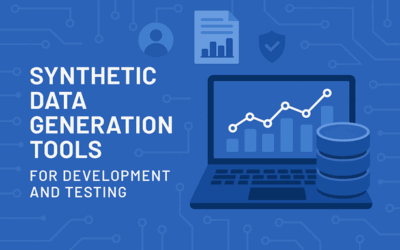
Test Data Management In Depth: The What and the How
09
DECEMBER, 2021
by Justin Reynolds.
When it comes down to it, test data is one of the most important components of software development. That’s because test data makes it possible to create applications that align with the exact needs and expectations of today’s customers. Quite simply, test data ensures greater software security, design, and performance.
Since test data plays such an important role in the software development process, it’s critical to have an adequate framework in place to handle it. After all, mismanaging test data can lead to a variety of issues—like compliance risks and underperforming digital services.
This post will cover what test data management is, best practices, and the top challenges that all organizations should know about.
What Is Test Data Management?
Before we dive into test data management, it’s important to have a solid understanding of how test data works.
Test data is data that companies use primarily for software testing—or non-production—purposes. Developers use test data to assess how software performs in different settings and environments. Broadly speaking, there are three types of test data: valid data, invalid data, and borderline data.
In one example, developers may use test data for performance testing. Test data can help determine how fast a system responds to certain workloads and conditions such as traffic spikes and connectivity lapses.
As another example, developers might use test data to determine whether a system is secure from malicious intruders. Test data can help ensure confidentiality, authentication, authorization, and integrity.
What Does Test Data Management Entail?
Before you can use test data, you first have to produce it. This is possible using test data management, which is the process of generating, optimizing, and shipping data for specific tests.
In general, there are two components to managing test data: preparation and usage.
1. Test Data Preparation
Test data preparation involves either moving data from production and preparing it for testing environments, or creating it from scratch.
When migrating data into test environments, data must first go through a comprehensive transformation process to ensure referential integrity, relationships, and quality.
There are generally three approaches to test data preparation. Developers may choose to clone production databases, create synthetic test data, or subset production databases.
2. Test Data Usage
Once data is ready for use, it goes to the developer, who then takes the information and deploys it for software testing.
At this stage, it’s critical to ensure that data is clean, accurate, and secure. Developers shouldn’t have to question whether the data they are using to run tests complies with industry or government regulations, or whether it’s subpar.
Best Practices for Test Data Management
While companies tend to have different strategies and systems for managing test data, the following best practices apply to just about any organization.
Prioritize Data Discovery
In most organizations, data tends to live on multiple devices and systems. It also tends to have many different forms.
As such, it’s critical to have a complete overview of your data. That way, you know where information is coming from before it goes into the preparation or usage stage. What’s more, data discovery can also help ensure there is adequate data for software testing.
Automate Compliance
Companies today face an ever-expanding list of industry and government regulations. Some of the most common examples include the Health Insurance Portability and Accountability Act (HIPAA), the General Data Protection Regulation (GDPR), and the California Consumer Privacy Act (CCPA).
Suffice it to say that it can be very difficult to stay on top of changing rules and regulations. At the same time, it is possible to avoid complications by using automated test data management platforms that streamline regulatory compliance and offer the latest updates and insights.
Use Strong Data Governance
Testing environments can pose significant security risks due to the vast amount of sensitive data that passes through them. It is therefore critical to deploy strong data governance and access control technologies to limit exposure during software testing and prevent unauthorized human and non-human identities from accessing sensitive information.
For example, companies may use security information and event management (SIEM) tools to monitor and restrict access to data in test environments.
Remember to Mask Data
When using sensitive data, it’s critical to mask—or de-identify—the information to protect the owner. Masking data helps ensure authentic and reliable test data while avoiding complaints, fines, and penalties.
Top Challenges of Test Data Management
Companies often experience a variety of challenges when managing test data. Unfortunately, this can slow down development and lead to a variety of negative outcomes. Therefore, it is necessary to be mindful of the following pitfalls when managing test data.
Test Data Shortage
To be successful at running tests, you need large volumes of accurate data. Oftentimes, developers start compiling test data only to find they have a shortage of viable information.
A common workaround for this is to generate synthetic data. While synthetic data isn’t as accurate as real data, it can still be helpful in certain use cases and can allow teams to run basic tests.
Managing Data at Scale
In some cases, companies may have too much data on hand. Having too much data drives up storage and processing costs and makes it harder to cull databases.
As such, you should consider deleting unnecessary test data, including duplications or outdated tests that are no longer useful.
Poor Performance Quality
Just because software passes through testing and goes into production doesn’t mean that it will automatically perform up to expected standards. Apps may suffer from a variety of performance issues related to factors like connectivity and device failure.
For this reason, it’s important to run predictive testing and get a sense of how an application will fare under a variety of different scenarios. Through comprehensive stress testing, it’s possible to plan ahead and mitigate the damage from potential failures before they occur—resulting in stronger and more resilient software.
Inefficient Manual Data Creation
Many developers choose to create test data manually and produce data to support specific tests. Manual test data creation can include valid, invalid, and null data.
Creating data manually takes a lot of time and pulls developers away from other projects. It can also result in errors, potentially leading to inaccurate or insecure tests.
The better approach is usually to automate data creation using powerful data generation tools that can produce large volumes of accurate data at scale. This can save time and lower the cost of data generation.
Lack of Expertise
Right now, there’s a massive developer shortage for companies across all verticals, which is making it harder to bring software to market.
Testing tools often require advanced training and specialized skills—especially for complex and sensitive data. Without the right people in place, this is a herculean task that’s hard to pull off.
How Enov8 Simplifies Test Data Management
At the end of the day, test data management can go one of two ways. It can empower developers and help create great software—or it can turn into a massive, expensive headache.
Enov8 delivers a platform that offers advanced visualization and automation across all stages of the software development life cycle, including test data management and delivery. With the help of Enov8, your company can reduce project times, lower expenditures, speed up DevOps workflows, and guarantee security and compliance. The platform is also user-friendly and doesn’t require any advanced training or deployment considerations.
To experience how Enov8 can enhance your test data management strategy, launch the in browse demo today.
Post Author
This post was written by Justin Reynolds. Justin is a freelance writer who enjoys telling stories about how technology, science, and creativity can help workers be more productive. In his spare time, he likes seeing or playing live music, hiking, and traveling.
Relevant Articles
7 Synthetic Data Generation Tools for Dev & Testing
In software development and testing, having access to high-quality, realistic data is crucial. But real production data is often sensitive, regulated, or simply unavailable for testing purposes. Synthetic data generation tools provide a powerful alternative, enabling...
The SAFe Hierarchy and Levels, Explained in Depth
The Scaled Agile Framework (SAFe) is a comprehensive set of principles and practices designed to help organizations adopt agile methods on an enterprise level. It provides a set of guidelines and best practices that enable large-scale product development with agility....
DORA Compliance – Why Data Resilience is the New Digital Battlefield
How Enov8 Helps Financial Institutions Align with the EU's Digital Operational Resilience Act Executive Introduction As of January 2025, the EU's Digital Operational Resilience Act (DORA) has become legally binding for financial institutions operating across the...
Data Fabric vs Data Mesh: Understanding the Differences
When evaluating modern data architecture strategies, two terms often come up: data fabric and data mesh. Both promise to help enterprises manage complex data environments more effectively, but they approach the problem in fundamentally different ways. So what’s...
What Is Release Management in ITIL? Guide and Best Practices
Managing enterprise software production at scale is no easy task. This is especially true in today’s complex and distributed environment where teams are spread out across multiple geographical areas. To maintain control over so many moving parts, IT leaders need to...
Test Environment: What It Is and Why You Need It
Software development is a complex process that requires meticulous attention to detail to ensure that the final product is reliable and of high quality. One of the most critical aspects of this process is testing, and having a dedicated test environment is essential...










